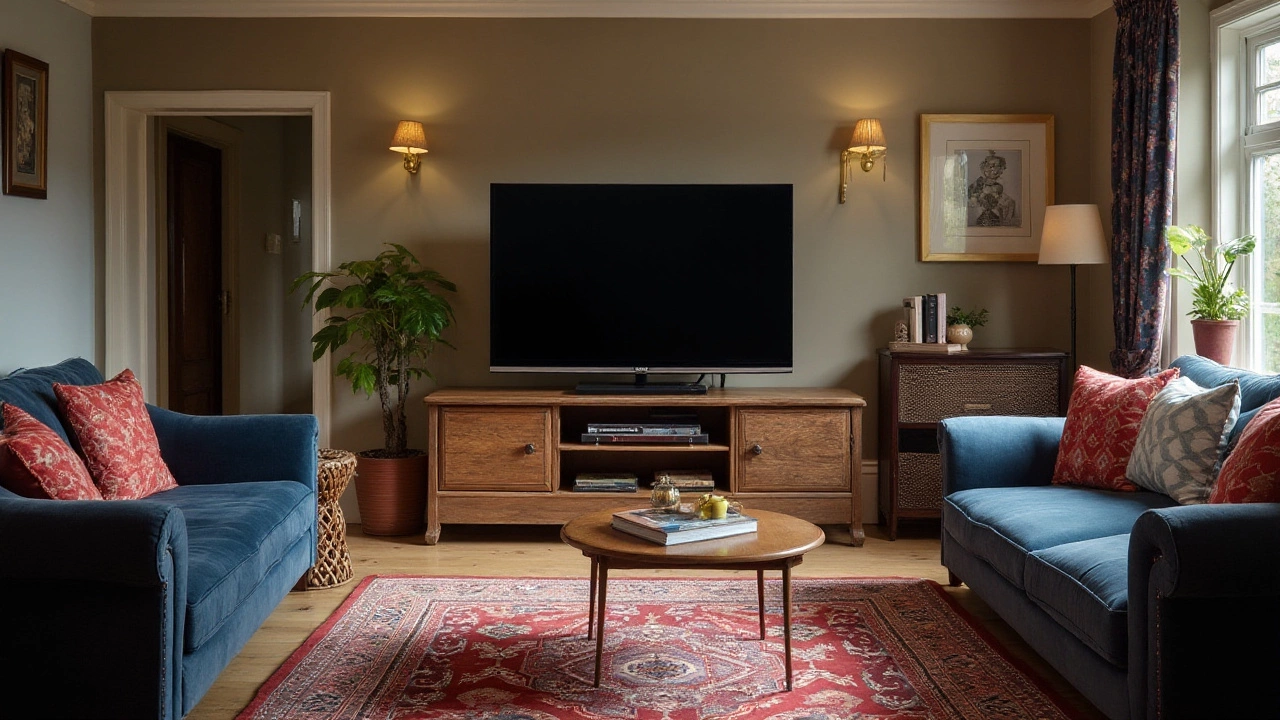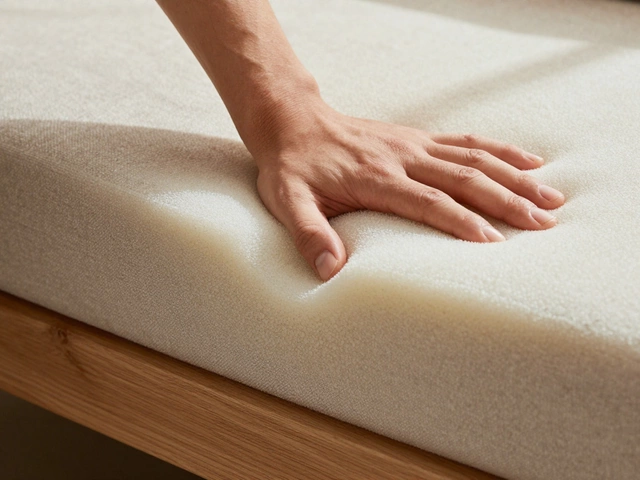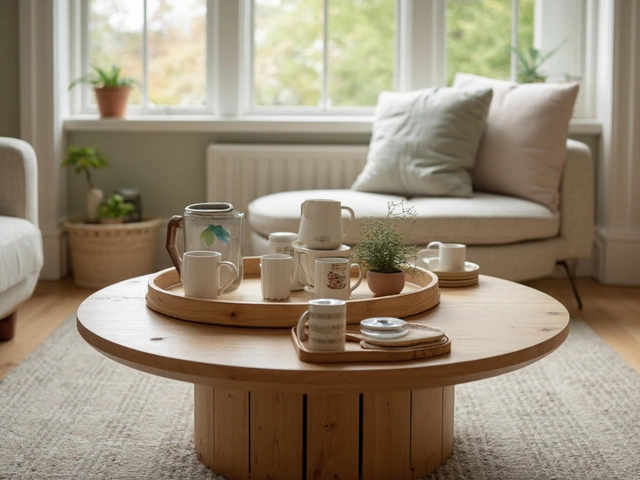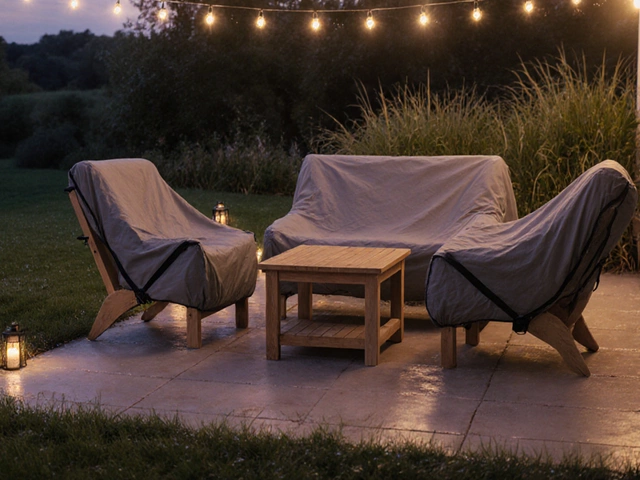Finding the perfect TV stand for a 65-inch television can be quite the quest, especially when you're trying to balance style, functionality, and space considerations. A good place to start is by understanding the actual dimensions of your TV. Most 65-inch TVs come with an average width of 57 inches, but slight variations can occur depending on design and brand.
While the measurement across the screen is the most cited number, the width is really what matters when considering where and how your TV is going to sit. Making the right choice goes beyond just the width, however, as you'll want to take into account the depth and height of the TV stand, ensuring it harmonizes with your furniture and interior design.
We'll also touch on the importance of style and substance. After all, a TV stand should complement or accentuate your living area while offering adequate storage for your media components. Let's delve into finding that perfect blend of aesthetic appeal and practical use!
- Understanding 65-Inch TV Dimensions
- Why TV Stand Width Matters
- Tips for Measuring Your Space
- Choosing the Right Style & Material
- Balancing Functionality and Aesthetics
- Final Tips for Complementing Your Setup
Understanding 65-Inch TV Dimensions
When it comes to a 65 inch TV, the dimension that most consumers focus on is the diagonal measurement. This measurement is the most straightforward as it represents the size across the screen itself, from one corner to the opposite one. However, when planning where to place this technological marvel, it's equally important to consider its width, height, and even depth. 65 inch TV dimensions typically display a width of approximately 57 inches and a height of around 32 inches, though these can vary slightly based on the model and manufacturing design.
A critical aspect you might not have thought about is the bezel size. Some TVs may have wider bezels that can affect how much actual space the TV occupies, impacting the TV stand or wall space you need. Another factor is the back panel depth – some models boast a slim profile, while others with integrated sound components may be slightly thicker. This is where a high-resolution model may differ, as these dimensions contribute to how the TV looks and fits into your living room. TV buying guide tips commonly emphasize these structural elements as crucial in determining the perfect fit for your home.
For those keen on synchronizing their TV setup with a variety of multimedia devices, you'll also need to account for space around the TV for cables and supporting gadgets. Consider the space for soundbars or gaming consoles that might be part of your entertainment ensemble. Selecting the right TV doesn't end with the screen size; comprehensive understanding of all dimensions ensures you don’t run into any surprises during setup. A useful TV stand guide can recommend allocating extra inches on either side of the stand to accommodate potential accessory additions later down the line.
For the tech enthusiasts keen on an impeccable installation, a more nuanced understanding of these dimensions greatly helps. According to Home Theatre Magazine, "A TV's dimensions, when poorly understood, can disrupt the balance of your entertainment area."
Choosing the right TV isn't merely about screen size but an intricate dance of understanding all the dimensions for harmony at home."By remaining informed, you make smarter purchasing decisions that save time and foster a splendid viewing environment.
For those interested in getting deep, you may be intrigued by specific stats that showcase size variations among leading brands. Here’s a look at potential width differences:
| Brand | Width (inches) |
|---|---|
| Samsung QLED | 57.4 |
| LG OLED | 57.2 |
| Sony Bravia | 57.5 |
As you navigate this aspect of the TV selection process, these fine details make a difference. These TV buying guide insights ensure clarity when embarking on the journey to achieve the perfect television aesthetic that matches your home décor, granting both peace of mind and visual delight.
Why TV Stand Width Matters
When it comes to setting up your home entertainment system, the width of a TV stand plays a crucial role, and it’s often overlooked until the last minute. Considering the width is imperative because without the right dimensions, you could end up with a setup that’s unstable and unsightly. To start off, the width of the stand dictates the balance and stability of your 65-inch TV. Typically, for a television this size, you'd want a TV stand that's at least as wide as the television or ideally a few inches longer. This ensures that your television is safely anchored and less likely to tip over from minor bumps or movements, which is especially important if you have young children like Brielle darting around the living room.
Another aspect to think about is the aesthetic impact of the stand’s width within your room layout. A too-narrow stand could make your gigantic screen look like it's teetering in place, whereas a broader stand offers a more grounded and integrated appearance. A wider stand also has added benefits when it comes to storage and organization, giving you ample space to house other electronics and hide those unsightly cables. “Ensuring that furniture, including TV stands, blend seamlessly while maintaining functionality is key to a harmonious living space,” says interior design expert Jane Michaels. Finding the right width doesn’t just serve a practical function; it enhances the visual harmony of your home.
From an ergonomic perspective, a suitably wide stand provides more than just stability and visual appeal. It also can influence viewing comfort. Ideally, a television should be seated at eye level. A wider stand often boasts a higher platform which positions your TV at the ideal height, reducing strain on your neck and eyes during those long movie nights or Saturday afternoon sports binges. Additionally, it can influence the acoustics of the room. A wider stand can provide a more balanced sound distribution, especially if you have speakers or sound systems incorporated into the stand.
In regards to the practical aspect of cable management, a wider stand offers you more hidden pathways and gaps to keep your streaming and gaming devices connected without a tangled mess of wires. You can take advantage of the extra surface area for decorative elements or additional gadgets, like speakers or smart home devices. This means you are not limiting your living space design to a single, funneled purpose. When choosing a TV stand, these functional factors are as vital as the measurements themselves; they help prevent future hassles and potential mishaps, ensuring your cinematic setup not only looks good but performs at its best.
The right width can also keep future investment in mind. Televisions, like fashion trends, change over time, and the last thing you want is for the new model you excitedly bring home to not match the stand. Opting for dimensions that are slightly wider and more flexible can save you the headache of having to replace your furnishings to accommodate your evolving technology preferences. Manufacturers’ recommendations suggest leaving 2-3 inches of additional space on either side of the TV for safety and aesthetic reasons, which serves as a useful pointer when considering future purchases.
A well-chosen TV stand becomes a focal point in your room, as it achieves the perfect balance between the artistic and the utilitarian aspects of your living space setup. So, it’s not just about how it looks but how well it performs over time. Take the time to measure and think through your space layout decisions, and you’ll thank yourself each time you settle down to watch your favorite shows and movies.
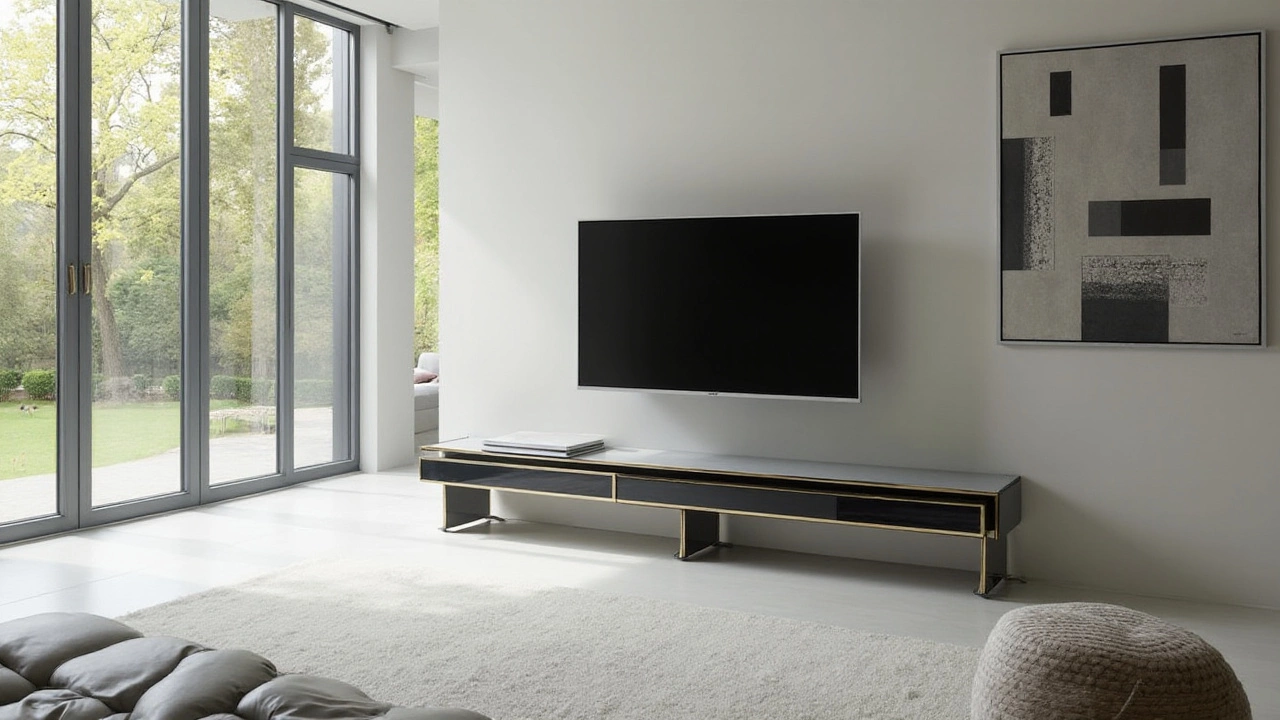
Tips for Measuring Your Space
When it comes to fitting your 65-inch TV into your living room, accurate measurements can make all the difference in ensuring both visual balance and practical use. Start by measuring the wall area where you'd like to hang or place the TV. You'll want to ensure that the width of the TV is compatible with the wall space. Remember, a 65-inch TV typically measures around 57 inches wide but can vary slightly depending on the model. Ensuring you have at least an inch or two on either side of the TV can offer a more aesthetic balance and allow for ventilation, which is crucial for the longevity of your electronics.
Next, measure the height from the floor to the center of where the TV will be situated. Eye level for a seated viewer is generally considered the most comfortable viewing height, roughly 42 inches above the floor. These handy measurements will guide you not just in placing the TV but also in selecting an appropriate TV stand that complements the setup. Don’t overlook measuring the depth too the TV stand should be deep enough to support the base of the TV, but not so deep that it awkwardly protrudes into the room. Achieving this balance requires some precision, ensuring a harmony between furniture and free movement space.
Avoid the temptation of just eyeballing it though your room's overall layout might seem spacious, once the TV and furniture are arranged, it could tell a different story. A useful strategy is using painter’s tape to outline the proposed TV dimensions directly onto the wall. This not only visualizes the final setup but also highlights potential space constraints or adjustments needed. Keep in mind any existing furniture or elements that might interact with your TV area, like bookshelves or side tables, to prevent congestion.
Consider the distance between your TV and seating area as well. For a 65-inch TV, a viewing distance of about 8 to 10 feet is often recommended to ensure the screen doesn’t dominate or strain the viewers' eyesight. A perfect fit doesn't just mean spatial compliance—it’s about creating a cohesive and comfortable viewing area that enhances your entertainment experience.
"Measure twice, cut once," is a time-tested mantra borrowed not just by carpenters, but applicable for anyone setting up household electronics—ensure each measurement step considers future adjustments.—Homes & Gardens Magazine
It’s crucial to account for cable management when measuring. Oh, those pesky cords! The last thing you’d want is a sea of wires crisscrossing your sleek setup. When planning your TV’s placement, make sure there’s a clear path to the outlets and any secondary devices, like soundbars or gaming consoles. Tidy cable management isn’t merely for aesthetics but also prevents safety hazards. As technology advances in leaps, incorporating contemporary wireless or hidden compartment options can give your setting a clutter-free appeal.
Choosing the Right Style & Material
When it comes to selecting a TV stand for a 65 inch TV, style and material play pivotal roles in defining the elegance and practicality of your living space. One prevailing trend is the minimalist approach, where sleek metal or glass stands accentuate a modern ambience. On the other hand, wooden TV stands, particularly crafted from oak or walnut, appeal to those who favor a classic or rustic aesthetic. Each material has its unique charm, durability, and maintenance requirements, making it crucial to weigh these factors carefully.
Metal TV stands are noted for their durability and sleekness but are best paired with contemporary décor. Their shiny surfaces and clean lines can give your space an industrial touch, ideal for urban flats that embrace the cosmopolitan vibe. Glass stands, while visually alluring due to their transparency, do require regular cleaning to maintain their gloss. They also tend to highlight the technology aspect of your setup, drawing attention to the 65 inch TV’s design and features, and enhancing that modern feel you've been yearning for.
Wooden stands, beloved for their warmth and robustness, offer an array of choices from light to dark finishes. They seamlessly integrate into traditional or cottage-inspired homes. A standout feature of wooden stands is their potential for storage; with plenty of shelves, drawers, and cabinet space, they provide ample room to house your myriad of multimedia accessories. Some wood types can significantly increase in value over time, offering not just function but a potential investment as well.
According to a survey by Architectural Digest, nearly 45% of homeowners opt for wooden TV furniture to complement their home’s aesthetic.
"The right TV stand should act as a seamless extension of your room’s design," notes interior designer—and founder of her own design house—Fiona Barratt. "It’s about creating harmony, not necessarily uniformity, between furniture pieces."
Stylistically, it is also important to consider whether the design of your chosen TV stand will allow for hidden cable management, a feature that can keep your entertainment area looking tidy. Open shelving might work for some minimalists who prioritize airflow for their electronic devices. Closed cabinets are a boon for those who prefer keeping remotes, wires, and gaming consoles out of sight.
Exploring innovative combination styles, such as a blend of metal with wood or glass, can offer a unique visual appeal that reflects personal taste while balancing aesthetics with functionality. The right blend can transform a simple television viewing setup into an exceptional point of interest in your room. Whether you lean towards the traditional or strive for the contemporary, the key is to choose a style and material that will both enhance your living space and functionally support your television setup.
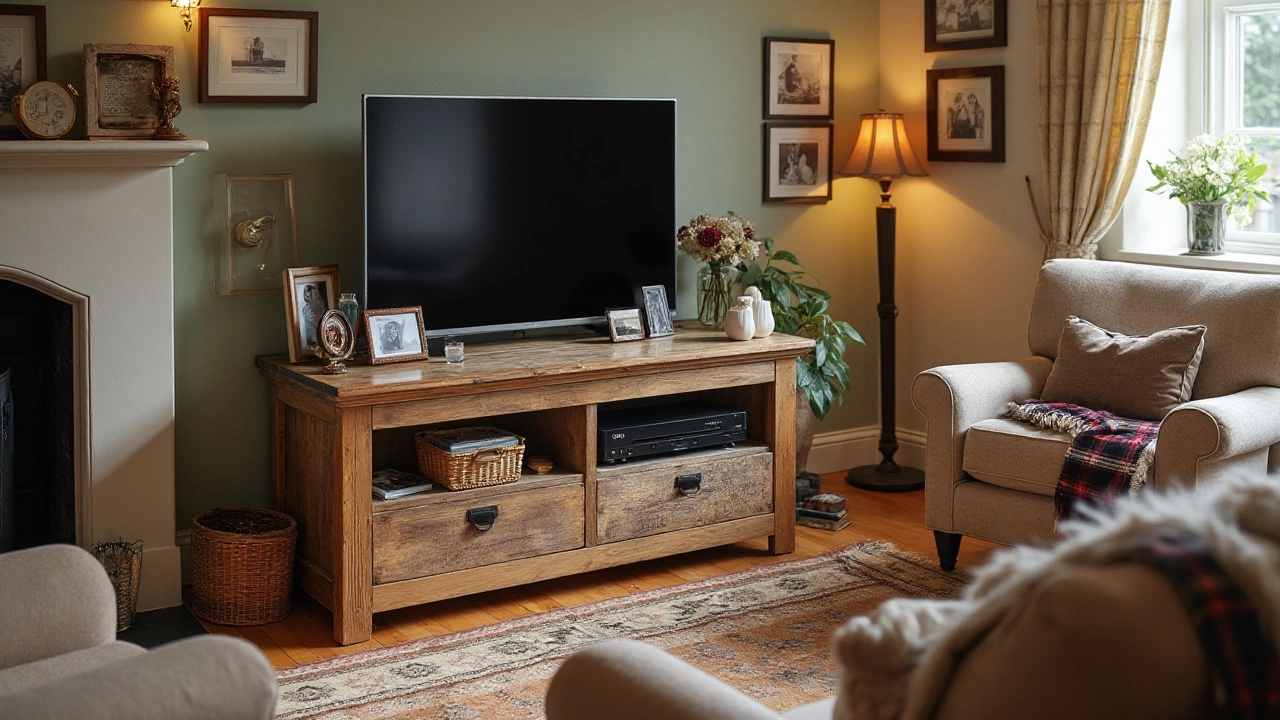
Balancing Functionality and Aesthetics
Finding the right balance between functionality and aesthetics in your TV setup can be a bit of a puzzle, but when the pieces fall into place, the result is marvellous. You might think of your 65 inch TV as a statement piece in the room, but the stand it's placed on is equally significant. First, there's the aspect of functionality. A good stand should not only hold up your TV stably but also provide storage for your media devices, such as Blu-ray players, soundbars, or gaming consoles. Consider the practicalities: a stand should have ample space, allowing air to circulate around heat-sensitive electronics, and should ideally have openings for cable management to keep things neat and tidy.
On the aesthetic side, visual harmony should not be overlooked. The style of the TV stand — modern, rustic, or traditional — can tie together the room's visual theme. Materials play a crucial role here. Wooden stands offer a classic warmth, while metal and glass can give a contemporary edge. It's essential that the color and texture of the stand complement the existing furniture and room decor. By focusing on these elements, you're crafting not just a place for a TV, but a viewing sanctuary.
Consider this insight from interior design expert Nate Berkus:
"Your home should tell the story of who you are and be a collection of what you love brought together under one roof."This perspective neatly summarizes the importance of aesthetic choice; a TV stand should not only meet technical needs but also reflect personal taste.
There's also the question of proportions. The stand should be slightly wider than the TV itself — about 2 inches on each side is a good rule of thumb. This extra width provides a balanced look and prevents the setup from appearing top-heavy. A good width reference for a 65 inch TV stand is around 60 to 72 inches. Depth and height are the next vital factors. Ensure the height fits your eye level when seated, about 42 inches from floor to the screen center tends to be optimal.
For those who appreciate a tidy living space, opt for TV stands with additional features like built-in drawers or shelves. It’s a dream to have places where you can smartly tuck away DVDs, manuals, or remote controls. If you’re someone who moves things around often, consider stands with wheels to allow flexibility without straining your back.
In terms of popular furniture choices, there's always the option of console tables which offer sleek, minimalist designs that can seamlessly blend with most interiors. Alternatively, entertainment centers or wall units create a focal point and are perfect for larger areas. Both styles offer varying levels of storage and can be customized to fit a wide range of TV sizes, including the popular 65 inch TV dimensions.
To aid in your selection, use this simple guide:
- Decide on the primary material based on room design.
- Consider additional features for extra storage.
- Ensure the unit offers safety measures, especially if children are in the home.
- Measure your space to verify the stand's dimensions suit your room and viewing preferences.
With these pointers, you’re well-equipped to make an informed decision that suits both functionality and style, creating an environment you’ll cherish each time you sit down to watch your favorite shows.
Final Tips for Complementing Your Setup
Creating a media space that echoes both functionality and aesthetic appeal doesn't have to be an overwhelming task. It begins with acknowledging the main components, like your 65-inch TV, and ensuring they fit seamlessly within the framework of your decor. Start by considering the style and color of your TV stand. Opt for shades that match or contrast your existing furniture. This can make your TV area stand out or blend in, depending on what you’re aiming for. Earthy tones can complement rustic spaces, while sleek finishes work wonders in modern setups.
When choosing a TV stand, focus on its material as well. Wood is traditional and timeless, offering a warm appeal that few can resist. On the other hand, glass or metal options are perfect for those who lean towards contemporary minimalist aesthetics. A clever mix of textures can add layers of interest to your living room. If possible, measure your TV and your room space accurately. Take into account not just the width but the depth and the length, ensuring everything aligns well within your room's layout.
Keep an eye on the space's lighting, which can dramatically impact the viewing experience. Avoid placing your 65-inch TV opposite windows where reflections can wreak havoc on clarity. Implement soft, indirect lighting such as floor or table lamps to create an atmosphere perfect for movie nights or binge-watching your favorite series in the evening. Don’t overlook the importance of sound; ensure there’s space for a soundbar or incorporate speakers into the design, tweaking the layout for optimal acoustics.
"A well-designed home is not only about beauty; it’s about making life easier," says renowned interior designer Kelly Hoppen. Her insights ring true when it comes to crafting a TV setup that doesn’t merely look good but also provides practical benefits.
Highlight your TV area with accessories that don't overshadow the main attraction. Think about adding a few well-placed plants, which can introduce a natural, calming touch. If you're a collector, display a few themed items that can initiate conversations during gatherings. When it comes to organizing, make sure your cables are hidden to maintain a clean look. Many TV stands come equipped with built-in cable management systems—utilizing these can keep your setup free from clutter.
Let's not forget about functionality. Consider TV stands with spacious drawers or shelves to store DVDs, remotes, game consoles, or even books. A clutter-free zone adds to the sophisticated feel and is easier to maintain. Remember, your entertainment area should reflect your personality and lifestyle, making it a welcoming place for family and hosting friends. With thoughtful planning and some stylish touches, your 65-inch TV can truly be the cornerstone of your entertainment paradise.
